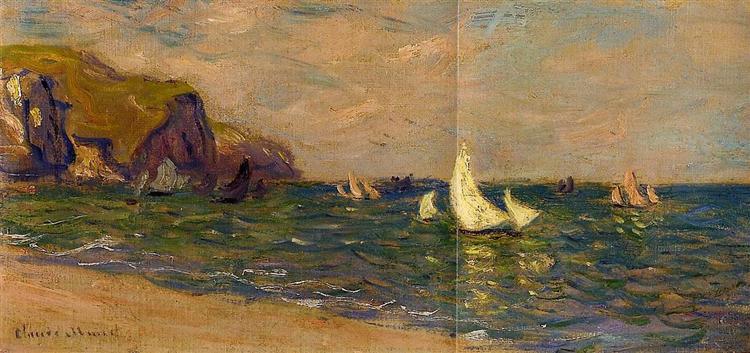Opis
Claude Monet's painting "Sailboats at Sea - Pourville" (1882) is one of the works that demonstrate the artist's mastery in the use of color and light, elements that were fundamental in the evolution of the impressionist style. This work, created in one of Monet's most fruitful stages, captures an ephemeral moment in the marine life of the Norman town of Pourville-sur-Mer, where the sea becomes a dynamic and vibrant stage.
Looking at the composition of the painting, one can see a balanced arrangement of elements. Monet presents a wide, calm sea in which several sailing boats are inscribed, arranged in such a way that they seem to float in a liquid world. The horizon is marked with a soft, thin line, suggesting a limitless sky and an environment that evokes a feeling of spaciousness. The position of the boats is especially significant; far from being mere objects, the sailboats come to life as characters within the work, each of them contributing to the narrative that unfolds on the surface of the water.
The use of color in “Sailboats at Sea - Pourville” follows Monet’s innovative approach. In this work, a palette is observed that integrates serene blues, soft turquoises and shades of white, all of them interspersed with touches of more vibrant color that reflect the action of the wind on the sails and the reflection of the sun on the surface of the sea. The loose, gestural brushstrokes provide a sense of harmonious movement, recreating the atmosphere of a day on the coast, where natural light plays a fundamental role in the interpretation of the landscape. Monet, known for his ability to capture light in his works, manifests an almost poetic feeling that transforms the everyday into something sublime.
Interestingly, “Sailboats at Sea - Pourville” not only showcases Monet’s fascination with the sea and sailing, but also delves deeper into man’s relationship with nature. Although there are no explicit human figures in the painting, the implied presence of the sailors is felt through the movement of the vessels and the dialogue between the sky and the water. This approach resonates with the Impressionist philosophy of capturing the visual experience and atmosphere of a moment, rather than the exact detail of reality.
Monet's work at Pourville falls within a period of exploration where the artist sought to capture the vibrations of light and colour. During this time, Monet led a very active life, travelling along the coasts of France and immortalising its natural beauty on canvas. Other works from this period, such as The Seasons or Impression, Rising Sun, have also addressed similar themes where light becomes the central subject. In Sailboats at Sea - Pourville, Monet achieves a perfect balance that makes the painting resonate with the immediacy of personal experience, evoking the scent of the sea and the sound of the waves.
This work, like many of Monet's achievements, is emblematic of a shift in artistic perception in the 19th century. Through his focus on light, color, and atmosphere, Monet not only defines the moment he finds himself in; he transcends it, inviting the viewer to share a fragment of the ephemeral beauty that captures their gaze.
"Sailboats at Sea - Pourville" stands as a testament to Monet's genius, where each brushstroke becomes a whisper of nature and of life itself. This work stands out not only for its visual beauty, but also for the emotional and sensorial depth it evokes, inviting a contemplation that goes beyond what is represented. At every glance, one is invited to rediscover the subtle dialogue between man and landscape, a constant theme in the work of the impressionist master.
KUADROS ©, a famous painting on your wall.
Hand-made oil painting reproductions, with the quality of professional artists and the distinctive seal of KUADROS ©.
Painting reproduction service with satisfaction guarantee. If you are not completely satisfied with the replica of your painting, we will refund 100% of your money.

